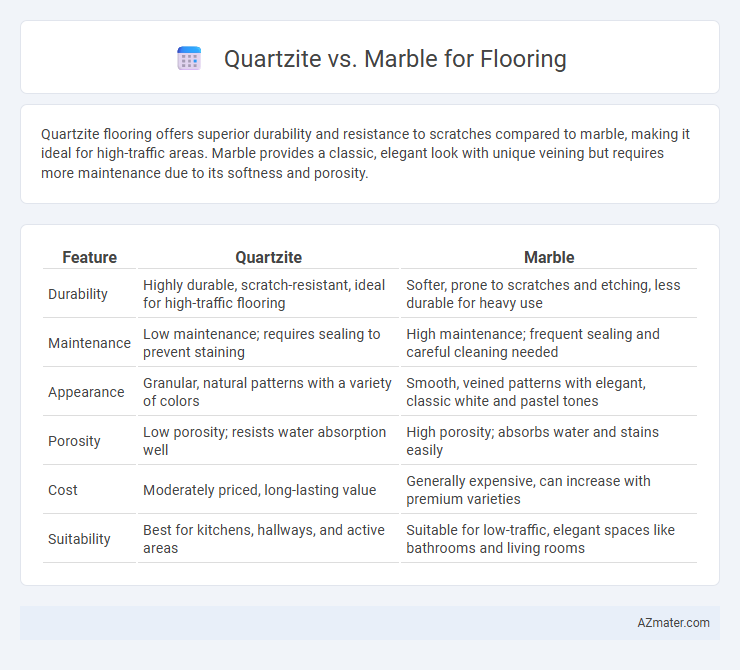Quartzite flooring offers superior durability and resistance to scratches compared to marble, making it ideal for high-traffic areas. Marble provides a classic, elegant look with unique veining but requires more maintenance due to its softness and porosity.
Table of Comparison
| Feature | Quartzite | Marble |
|---|---|---|
| Durability | Highly durable, scratch-resistant, ideal for high-traffic flooring | Softer, prone to scratches and etching, less durable for heavy use |
| Maintenance | Low maintenance; requires sealing to prevent staining | High maintenance; frequent sealing and careful cleaning needed |
| Appearance | Granular, natural patterns with a variety of colors | Smooth, veined patterns with elegant, classic white and pastel tones |
| Porosity | Low porosity; resists water absorption well | High porosity; absorbs water and stains easily |
| Cost | Moderately priced, long-lasting value | Generally expensive, can increase with premium varieties |
| Suitability | Best for kitchens, hallways, and active areas | Suitable for low-traffic, elegant spaces like bathrooms and living rooms |
Introduction to Quartzite and Marble Flooring
Quartzite flooring offers exceptional hardness and durability, making it ideal for high-traffic areas and resistant to scratches and stains. Marble flooring, prized for its elegant veining and smooth finish, provides a luxurious aesthetic but requires more maintenance due to its susceptibility to etching and staining. Both natural stones are popular in interior design but differ significantly in durability, maintenance, and appearance, influencing their best uses in flooring applications.
Key Differences Between Quartzite and Marble
Quartzite is an exceptionally hard and durable natural stone, making it highly resistant to scratches and suitable for high-traffic flooring areas. Marble, while elegant with its distinctive veining, is softer and more porous, requiring regular sealing and maintenance to prevent staining and etching. The key differences in durability, maintenance needs, and resistance to wear define quartzite as a more practical option for flooring compared to marble's aesthetic appeal.
Appearance and Aesthetic Variation
Quartzite flooring offers a highly durable surface with a natural, granular texture and a wide range of colors from soft whites to vibrant blues, showcasing unique, intricate veining patterns that resemble marble but with greater variation. Marble flooring is prized for its classic, elegant appearance featuring smooth, polished surfaces and distinctive veining in shades of white, black, green, and pink, giving each slab an individual artistic flair. The aesthetic variation in quartzite tends to be more diverse and rugged, while marble provides a timeless, luxurious look favored in traditional and upscale interior designs.
Durability and Strength Comparison
Quartzite offers superior durability and hardness compared to marble, making it highly resistant to scratches, heat, and heavy foot traffic in flooring applications. Marble, being softer and more porous, is more prone to etching, staining, and wear over time, requiring more frequent maintenance and sealing. For high-traffic areas, quartzite's strength and resilience provide a long-lasting flooring solution with minimal damage risk.
Maintenance and Cleaning Requirements
Quartzite flooring offers superior durability and resistance to stains and scratches, requiring only regular sweeping and occasional damp mopping with mild detergent to maintain its appearance. Marble, while visually elegant, demands more meticulous care, including frequent sealing and gentle cleaning with pH-neutral products to prevent etching and staining. Quartzite's low porosity makes it easier to maintain long-term compared to marble's higher susceptibility to moisture and chemical damage.
Cost Analysis: Quartzite vs Marble Flooring
Quartzite flooring generally costs between $7 to $15 per square foot, making it a more affordable option compared to marble, which ranges from $10 to $20 per square foot. Quartzite's durability and resistance to scratching reduce long-term maintenance expenses, while marble often requires regular sealing and polishing that increase upkeep costs. Choosing quartzite offers a cost-effective balance of aesthetic appeal and durability, whereas marble commands a premium price with higher maintenance demands.
Resistance to Stains, Scratches, and Etching
Quartzite offers superior resistance to stains, scratches, and etching compared to marble, making it an ideal choice for high-traffic flooring areas. Its natural hardness and dense composition prevent damage from acidic substances and everyday wear, ensuring long-lasting durability. Marble, while aesthetically appealing, is more porous and prone to etching and staining, requiring regular sealing and careful maintenance to preserve its appearance.
Installation Process and Considerations
Quartzite flooring requires professional installation due to its hardness and density, which demand specialized tools for cutting and shaping. Marble is softer and easier to cut, allowing for more DIY-friendly installation but needs careful handling to avoid chipping or cracking. Both materials require sealing to protect against stains; however, quartzite's higher durability makes it less prone to etching and scratching during everyday use.
Environmental Impact and Sustainability
Quartzite flooring is favored for its durability and minimal environmental footprint, as it requires less intensive mining and processing compared to marble. Marble extraction and production often involve significant energy consumption and produce higher waste levels, raising concerns about sustainability. Choosing quartzite supports eco-friendly building practices due to its longevity and reduced maintenance needs, contributing to lower overall resource use.
Choosing the Right Stone for Your Space
Quartzite offers exceptional durability and resistance to scratches, making it ideal for high-traffic flooring areas, while marble provides a classic, elegant appearance with unique veining patterns but requires more maintenance due to its softness and susceptibility to staining. Quartzite's natural hardness and resistance to heat also make it practical for kitchens and entryways, whereas marble is better suited for low-traffic or decorative spaces like bathrooms or living rooms. Selecting the right stone depends on balancing durability needs with aesthetic preferences and maintenance commitment for your specific space.

Infographic: Quartzite vs Marble for Flooring
 azmater.com
azmater.com